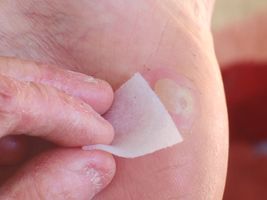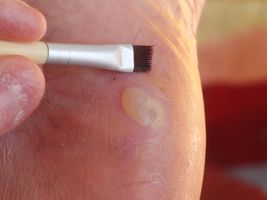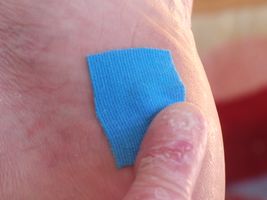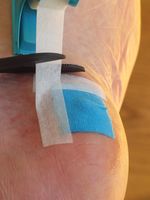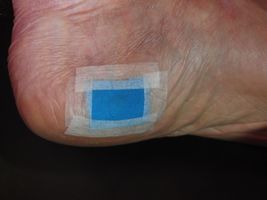Taping your feet to prevent or treat blisters
Taping may be required to prevent blisters or if they occur anyway, to help treat them. Different tapes have different properties, and it's best to gain experience with different tapes before using them in a race. Even putting a piece of tape on the edge of your hand will give you an idea of how well it stick and how flexible it is.
Contents
1 General Taping Tips
- Practice taping for your training runs – remember The Golden Rule of Racing
- Remember your feet may swell so avoid taping too tightly.
- If you get a blister, taping can prevent it getting worse and can relieve the pain.
- Taping a blister can create more pressure on the blister if done incorrectly.
- You can tape a blister with or without popping it. Popping a blister is a bad idea, but sometimes it's necessary if the blister will spread.
- Taping should be a last resort; try to fix the underlying problem first.
2 Tapes
- Micropore[1] This is my default tape, partly because I have been using Micropore from my earliest memories due to my skin condition. Micropore is very thin, smooth and inflexible, but not very sticky, so you need to use it with an adhesive promoter. The biggest problem with Micropore is that it is not very durable. I find it will last well enough for a race, but I like to tape a day or two ahead of time to make sure the tape is right, and it can suffer wear in the mean time.
- Leukotape P [2] This is thicker, slightly rough textured, inflexible tape. It works very well when you need something more robust than Micropore.
- Elastikon[3] This tape is thicker than any of the others, slightly rough, but flexible and porous.
- Kinesio-Tex This is a soft tape that stretches in one direction. I find that it does not stick well without an adhesive promoter, though rubbing the tape to warm it before applying will help it stick a little better. I also find the edges tend to fray, so I will often use some Micropore to stick the edges down.
- Duct Tape I strongly recommend against using duct tape, as it is not breathable, so the skin tends to become saturated underneath. Duct Tape also tends to wrinkle, creating creases that cause further problems. Like many other tapes, you need to use it with an adhesive promoter to get it to stick effectively. Watch the edges, as they tend to catch and then the tape then rolls up. I have used Micropore on the edges, with some success.
3 Adhesive Promoter
- Friar's Balsam[4] Also known as Tincture of Benzoin, this helps tapes stick much better. I find it important to apply the balsam to the area where the tape is going to be placed; If you miss a spot, then the tape will tend to lift up in that spot. If you over apply it, you can remove the excess with rubbing alcohol or smother it with talcum powder.
- Mastisol[5] This is seems to work better than Friar's Balsam – it is claimed to be 7-10 times sticker. I'm not sure if that is true, but it does work remarkably well. Easy to apply, but expensive!
4 Adhesive Remover
- Detachol[6] This adhesive remover works great for removing tape, especially around blisters. You still have to be careful, easing up the edges and applying some of the detachol, but it's quite easy. I use a cotton bud to rub the detachol at the point where the tape meets the skin. It seems to leave no residue or upset the skin in any way.
5 How to tape a blister
This is the taping technique I generally use. For minor issues, just Micropore works well, but for a something more delicate, the combination of Kinesio-Tex and Micropore is better.
- Taping a blister
Cut the Kinesio-Tex tape a little larger than the blister. Bigger gives more sticking area, which is good, but the extra coverage can cause that skin to become saturated with sweat, so it's a compromise. Push down on the tape around the blister to make a good seal. You're looking to create pressure and a little heat.
6 Pre-Taping
As well is taping a blister that has already occurred, it is possible to take before the race begins. There are advantages and disadvantages to this approach, and if possible, it is far better to avoid the underlying causes of blistering.
6.1 Advantages of pre-taping
- If you found no way of preventing the blisters then pre-taping may help.
- Pre-taping is done on dry skin, so generally adhesion is much better.
- And you can spend a lot more time doing the pre-taping than is possible or practical during the actual race.
- Some adhesives seem to become stronger after a day or so.
- Taping a day or two before the race allows you to check the taping fits correctly and is not going to cause a problem.
6.2 Disadvantages of pre-taping
- It's harder to check if a blister is forming if you've pre-taped your feet. I've seen a number of runners who were convinced they had blisters when in fact it was just a hotspot.
- The taping has to last for the full length of the race when you pre-tape, which can be a challenge for longer races. Always use an adhesive promoter when pre-taping.
- It's possible for the tape to ruck up and actually cause a blister rather than prevent one. I've had tape come loose and migrate to a different part of the foot where it caused a blister that would never otherwise have occurred.
- Your feet may swell during the race, and taping can cause constriction. This is especially a problem if you tape around a toe.
6.3 Approaches to pre-taping
There are two approaches to pre-taping; Spot taping and area taping. Spot taping is where you apply tape to a small area that is blister prone. I have found that this can be a useful approach if you have a particular vulnerability. Area taping involves applying tape to a large portion of the foot, creating what amounts to a tape-based sock. The advantages of area taping are that the edges of the tape are well away from the pressure zones. However, area taping is generally trickier to get right.
6.4 Tapes for pre-taping
You may find that different takes are appropriate for pre-taping, as there is no blister that requires protection. I generally prefer Micropore for pre-taping, as it is low friction and reduces any stretching forces on the skin.
7 Also See
- Fixing Your Feet is a great book that includes details of taping
- Blister Prevention
- Popping Blisters
- Blister Prevention and Socks
- Toughening Feet
8 References
- ↑ http://www.zombierunner.com/store/categories/foot_care/tapes/product6.html Micropore at Zombie Runner
- ↑ http://www.zombierunner.com/store/categories/foot_care/tapes/product967.html Leukotape P at Zombie Runner
- ↑ http://www.zombierunner.com/store/categories/foot_care/tapes/product1.html
- ↑ http://www.zombierunner.com/store/categories/foot_care/adhesives/product125.html Friar's Balsam/Tinture of Benzoin at Zombie Runner
- ↑ http://www.zombierunner.com/store/categories/foot_care/adhesives/product1026.html Mastisol at Zombie Runner
- ↑ Eloquest Healthcare Detachol http://www.eloquesthealthcare.com/products/detachol.aspx
